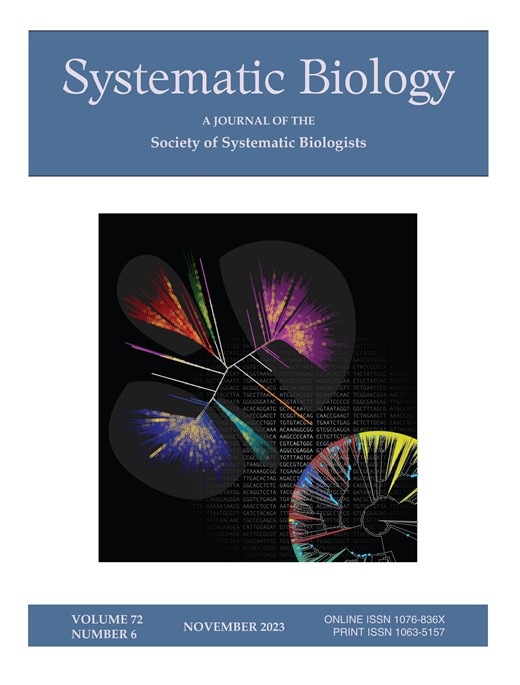全球气候变冷促使跳蝶多样化
IF 5.7
1区 生物学
Q1 EVOLUTIONARY BIOLOGY
引用次数: 0
摘要
描述控制物种丰富谱系多样化的驱动因素具有挑战性。虽然蝴蝶是被研究得最充分的昆虫群体之一,但很少有全面的研究调查它们的多样化动态。在这里,我们重建了大约1500个跳蛛科物种的系统基因组树,以测试历史全球气候变化、地理范围进化和寄主-植物关联是否是多样性的驱动因素。我们的研究结果表明,在白垩纪-古近纪大灭绝之前,在以白令陆桥为中心的北部地区,跳船起源于劳亚,然后在全球气候变冷的同时向南部地区殖民。在整个新生代,气候变冷也促进了跳船的多样化,可能是通过推动生物群落从封闭的生态系统向开放的生态系统(如草原)转变。早期从双食到单食的转变降低了灭绝率,增加了物种形成率,解释了食草适应跳船的巨大多样性。与长期气候变化相关的动态地理范围演变和寄主植物转移解释了跳蝶的多样化。本文章由计算机程序翻译,如有差异,请以英文原文为准。
Global climate cooling spurred skipper butterfly diversification
Characterizing drivers governing the diversification of species-rich lineages is challenging. Although butterflies are one of the most well-studied groups of insects, there are few comprehensive studies investigating their diversification dynamics. Here, we reconstruct a phylogenomic tree for ca. 1,500 species in the family Hesperiidae, the skippers, to test whether historical global climate change, geographical range evolution, and host-plant association are drivers of diversification. Our findings suggest skippers originated in Laurasia before the Cretaceous-Paleogene mass extinction, in a northern region centered on Beringia before colonizing southern regions coinciding with global climate cooling. Climate cooling also fostered the diversification of skippers throughout the Cenozoic possibly by fueling biome transitions from closed to open ecosystems such as grasslands. An early shift from dicot-feeding to monocot-feeding reduced extinction rates and increased speciation rates, explaining the large diversity of grass-feeding adapted skippers. A dynamic geographic range evolution and host-plant shifts linked with long-term climate change explain skipper butterfly diversification.
求助全文
通过发布文献求助,成功后即可免费获取论文全文。
去求助
来源期刊

Systematic Biology
生物-进化生物学
CiteScore
13.00
自引率
7.70%
发文量
70
审稿时长
6-12 weeks
期刊介绍:
Systematic Biology is the bimonthly journal of the Society of Systematic Biologists. Papers for the journal are original contributions to the theory, principles, and methods of systematics as well as phylogeny, evolution, morphology, biogeography, paleontology, genetics, and the classification of all living things. A Points of View section offers a forum for discussion, while book reviews and announcements of general interest are also featured.
 求助内容:
求助内容: 应助结果提醒方式:
应助结果提醒方式:


